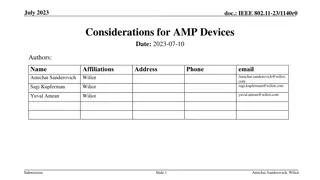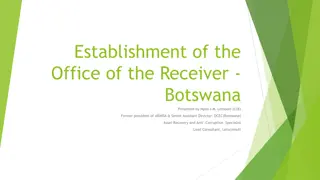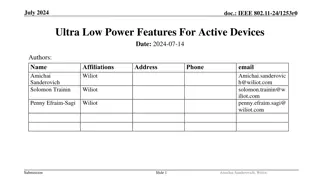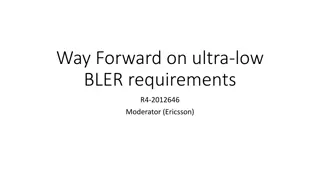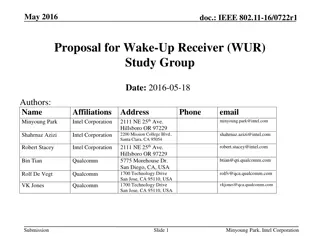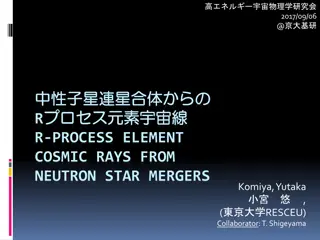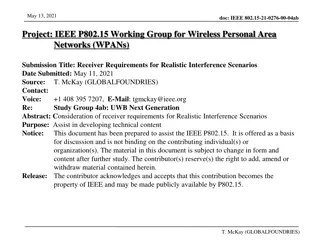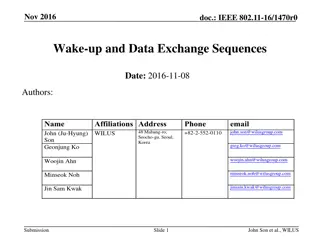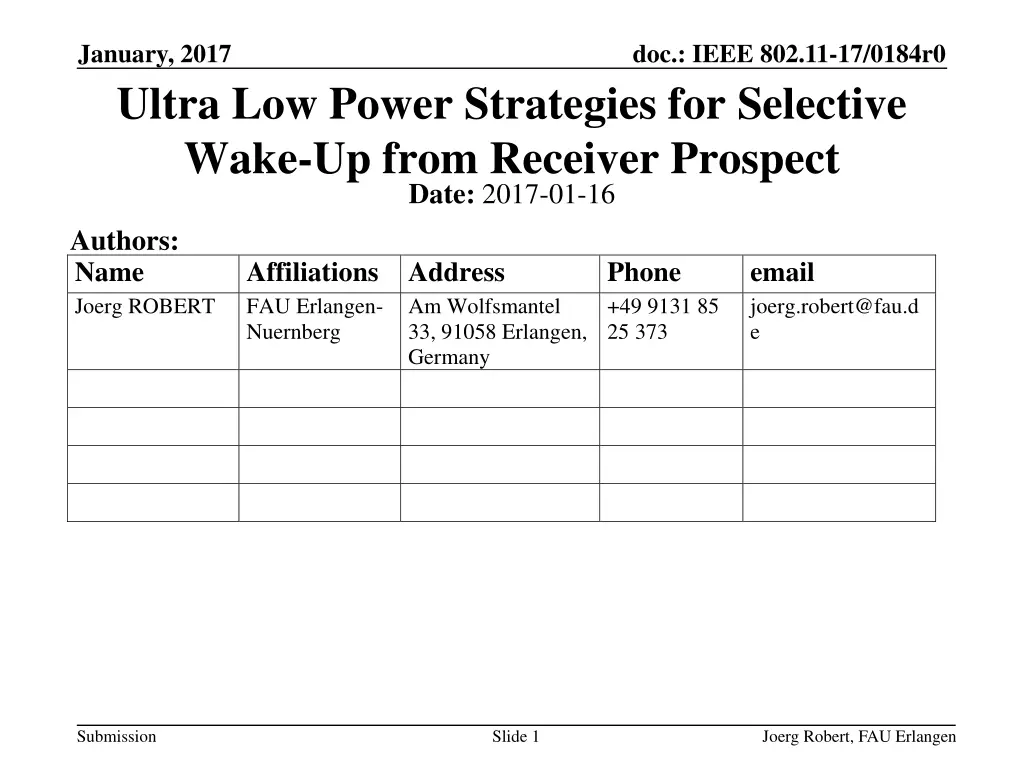
Ultra Low Power Strategies for Selective Wake-Up from Receiver Prospect
Explore ultra-low power strategies for wake-up receivers to achieve power consumptions below 10 W, focusing on a proposed 2-stage protocol for wake-up packet that combines low power capability with high data rate. Learn about selective wake-up of groups in large networks to maintain low latency and power consumption.
Download Presentation

Please find below an Image/Link to download the presentation.
The content on the website is provided AS IS for your information and personal use only. It may not be sold, licensed, or shared on other websites without obtaining consent from the author. If you encounter any issues during the download, it is possible that the publisher has removed the file from their server.
You are allowed to download the files provided on this website for personal or commercial use, subject to the condition that they are used lawfully. All files are the property of their respective owners.
The content on the website is provided AS IS for your information and personal use only. It may not be sold, licensed, or shared on other websites without obtaining consent from the author.
E N D
Presentation Transcript
January, 2017 Ultra Low Power Strategies for Selective Wake-Up from Receiver Prospect Date: 2017-01-16 Authors: doc.: IEEE 802.11-17/0184r0 Name Joerg ROBERT Affiliations Address FAU Erlangen- Nuernberg Phone +49 9131 85 25 373 email joerg.robert@fau.d e Am Wolfsmantel 33, 91058 Erlangen, Germany Submission Slide 1 Joerg Robert, FAU Erlangen
January, 2017 doc.: IEEE 802.11-17/0184r0 Abstract This presentation shows: sampling wake-up receivers offer ultra-low power consumptions below 10 W proposed 2-stage protocol for wake-up packet benefits from scalability of sampling WURs combination of very low power capability with very high data rate (e.g. 250 kbps) is feasible selective wake-up of groups (multicast/broadcast) Submission Slide 2 Joerg Robert, FAU Erlangen
January, 2017 doc.: IEEE 802.11-17/0184r0 Relevant Proposed Issues WUR Requirements [1]: Target power consumption of Wake-up radio < 100 W OOK modulation scheme Narrow bandwidth (e.g. < 5 MHz) Latency < 100 ms Recent WUR publications exhibit power consumptions > 200 W for 250 kbps data rate. Too high for many IoT applications [5]. Selective Wake-Up [3]: Not only individual, but group wake-up required (esp. for large networks) Keeps both latency and power consumption at a low value Submission Slide 3 Joerg Robert, FAU Erlangen
January, 2017 doc.: IEEE 802.11-17/0184r0 2-Stage Protocol: Two Different Data Rates 802.11 Compliant Wake-Up Packet scheme [2], [4]: OOK Wake-Up Packet with 250 kbps within OFDM scheme using 13 subcarriers, bandwidth: 4.06 MHz Modification of wake-up packet, cf. [2]: Two data rates Preamble: lower data rate (reduces WUR listening power), e.g. 31-bit PN sequence for correlation. WUR data (MAC address etc.): at 250 kbps Submission Slide 4 Joerg Robert, FAU Erlangen
January, 2017 doc.: IEEE 802.11-17/0184r0 2-Stage Protocol: Two Different Data Rates Modified wake-up packet: Slow WUR preamble is followed by high data rate block: Address type: individual/group/broadcast address mode (e.g. 8 bit) MAC header: MAC address (48 bit) Frame body: optional command code (e.g. 16 bit) FCS: e.g. 32 bit CRC in total: e.g. 104 bit, 416 s Submission Slide 5 Joerg Robert, FAU Erlangen
January, 2017 doc.: IEEE 802.11-17/0184r0 Superregenerative Receiver Operation [8]: Feedback within RF oscillator is periodically tuned from positive (stable) to negative feedback (oscillation) by quench signal Amplified RF antenna signal is fed into RF oscillator and shifts turnover point (start of oscillation) Good selectivity (RF BW < 10 MHz) Acts as always-on receiver, PWUR = 200 .. 500 W Submission Slide 6 Joerg Robert, FAU Erlangen
January, 2017 doc.: IEEE 802.11-17/0184r0 Sampling Receiver Function Principle [9]: RF receiver front-end samples RF antenna signal within a very short period, e.g. 100 ns, and performs an OOK demodulation for each sample Between two samples the RX front-end is turned OFF The ratio of on-duty time interval TON and period TA is chosen at a very low value, e.g. 0.1% power consumption : 1000 Suitable for various data rates Internal RF oscillators calibrated XTAL oscillator at 32.768 kHz as reference needs ~ 1 W Submission Slide 7 Joerg Robert, FAU Erlangen
January, 2017 doc.: IEEE 802.11-17/0184r0 Dutycycling WUR vs. Sampling WUR (I/III) Cycle or Latency DutyCycled WUR [6] incl. 1 W XTAL Osc. 32 kHz Sampling WUR [7] incl. 1 W XTAL Osc. 32 kHz Sampling Superregenerative WUR [8] incl. 1 W XTAL Osc. 32 kHz 8 ms 56 W 14 W 4.5 W 15 ms 30 W 7.4 W 2.8 W 30 ms 15 W 4.2 W 1.9 W 60 ms 8.2 W 2.6 W 1.4 W [6]: Superregenerative receiver, 215 W @ 250 kbps. Dutycycling of WUR according to [1], slide 14. [7]: Sampling receiver with scalable data rate, suitable for ultra- low power consumption applications, but at lower data rates. [8]: Sampling Superregenerative WUR, scalable data rate. Extension to 250 kbps yields in 220 W power consumption. Submission Slide 8 Joerg Robert, FAU Erlangen
January, 2017 doc.: IEEE 802.11-17/0184r0 Dutycycling WUR vs. Sampling WUR (II/III) CCI 2 ms 2 ms 2 ms WUR off LP-WUR on LP-WUR on LP-WUR on WUR off Dutycycling of Wake-Up Receiver (packetwise): e.g. WUR 2 ms ON, 98 ms OFF (cf. [1], pp. 12-14) reduces average WUR power consumption, but inserts new latency in case of interfered 2-ms-packets (CCI): packet lost/missed, latency becomes N 100 ms Sampling Wake-Up Receiver: data reception spread over multiple, short samples in case of a 2-ms-interferer: only parts of packet lost, errors are tolerable due to FEC higher robustness WUR active: Short samples ... Wake-Up packet (LDR) Submission Joerg Robert, FAU Erlangen Slide 9
January, 2017 doc.: IEEE 802.11-17/0184r0 Dutycycling WUR vs. Sampling WUR (III/III) CCI 2 ms 2 ms 2 ms WUR off LP-WUR on LP-WUR on LP-WUR on WUR off Dutycycling of Wake-Up Receiver (packetwise): shortest on-duty time limited due to settling time (~ 1 s) of analog components (filters, amplifiers, bandgap ref.s) of low frequency oscillators (XTAL, RC ..) Sampling Wake-Up Receiver: on-duty time optimized to low values < 100 ns use of fast-settling components (filters, oscillators, amplifiers) with settling times of 10 ns .. 30 ns power consumption gets lower WUR active: Short samples ... Wake-Up packet (LDR) Submission Joerg Robert, FAU Erlangen Slide 10
January, 2017 Scalability of Power Consumption and Data Rate doc.: IEEE 802.11-17/0184r0 Sampling receiver [7] Wake-up preamble duration vs power consumption trade-off Data rate can be freely chosen and extended up to 250 kbps Preamble detection is tolerant towards bit Suitable for 2-stage protocol: Ultra-low power mode for e.g. 15.1-ms-wake-up preamble: 6.4 W high data rate mode for residual wake-up packet data (e.g. 820 W@250 kbps using [7]) Submission Slide 11 Joerg Robert, FAU Erlangen
January, 2017 doc.: IEEE 802.11-17/0184r0 Investigation on Periodic Wake-Up Access Ultra-low power mode of sampling WUR [7] suitable for continuous preamble WUR listening access period is dependent of user activity or other events 802.11 wake-up poll every 2 seconds yields in 5.7 W preamble power mode deter- mines minimum average power consumption of WUR, here i.e. 6.4 W (preamble: 15.1 ms) total WUR packet: 15.52 ms NB: LR44 (130 mAh) supplies 7 W for 3 years Submission Slide 12 Joerg Robert, FAU Erlangen
January, 2017 doc.: IEEE 802.11-17/0184r0 Conclusions Sampling wake-up receivers offer ultra-low power consumptions below 10 W The proposed 2-stage protocol for wake-up packet benefits from scalability of sampling WURs Combination of very low power capability with very high data rate (e.g. 250 kbps) is feasible Sampling WUR offer higher robustness in case of interference Submission Slide 13 Joerg Robert, FAU Erlangen
January, 2017 doc.: IEEE 802.11-17/0184r0 References [1] IEEE 802.11-16/0027r0, LP-WUR (Low-Power Wake-Up Receiver): Enabling Low-Power and Low-Latency Capability for 802.11 [2] IEEE 802.11-16/0341r0, LP-WUR (Low-Power Wake-Up Receiver) Follow-Up [3] IEEE 802.11-16/0950r0, Considerations on WUR Design [4] IEEE 802.11-16/1506r1, Coexistence Mechanism for Wakeup Radio Signal (follow-up) [5] IEEE 802.11-1045r09, A PAR Proposal for Wake-up Radio [6] J. Ayers, K. Mayaram and T. S. Fiez, "An Ultralow-Power Receiver for Wireless Sensor Networks," in IEEE Journal of Solid-State Circuits, vol. 45, no. 9, pp. 1759-1769, Sept. 2010. [7] J. Robert, T. Lindner and H. Milosiu, "Sub 10 W wake-up-receiver based indoor/outdoor asset tracking system," 2015 IEEE 20th Conference on Emerging Technologies & Factory Automation (ETFA), Luxembourg, 2015, pp. 1-3. Submission Slide 14 Joerg Robert, FAU Erlangen
January, 2017 doc.: IEEE 802.11-17/0184r0 References [8] M. Eppel, H. Milosiu and F. Oehler, "A novel 1 W super-regenerative receiver with reduced spurious emissions and improved co-channel interferer tolerance," 2016 IEEE Topical Conference on Wireless Sensors and Sensor Networks (WiSNet), Austin, TX, 2016, pp. 85-88. [9] H. Milosiu et al., "A 3- W 868-MHz wake-up receiver with 83 dBm sensitivity and scalable data rate," 2013 Proceedings of the ESSCIRC (ESSCIRC), Bucharest, 2013, pp. 387-390. Submission Slide 15 Joerg Robert, FAU Erlangen



